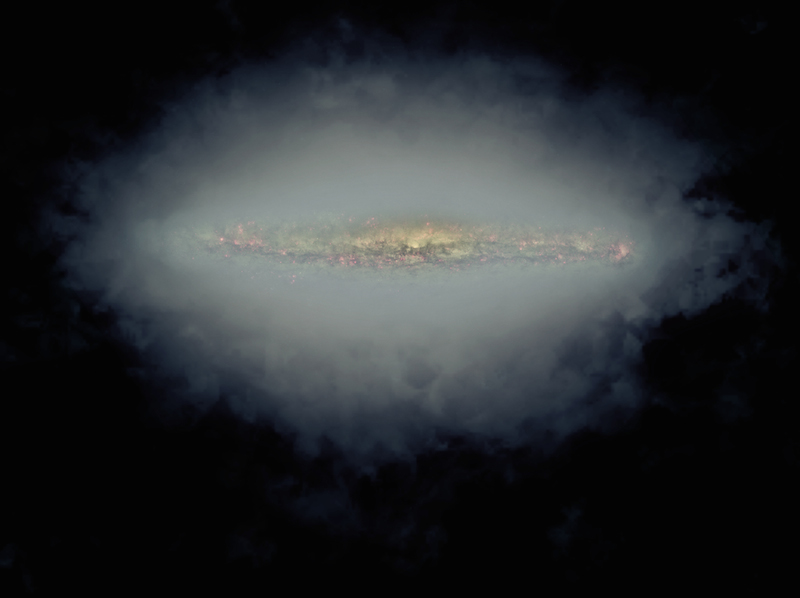
The median edge-on spiral galaxy at radio telescope frequencies around 1.5 ghz (l-band), made from stacking 30 CHANG-ES observations of galaxies. This image shows that the typical spiral galaxy is surrounded by a substantial halo of radio continuum emitting matter. The radio halo is colourized blue-grey. The galaxy in the centre is intended to represent the inner star forming region of spiral galaxies. It is constructed out of data from the Hubble space telescope of galaxy NGC 5775. // Photo: Jayanne English (University Of Manitoba) with support from Judith Irwin and Theresa Wiegert (Queen's University, Canada), for the CHANG-ES Consortium, Jansky VLA (NRAO), HST (NASA).
Listening to extragalactic radio
Astronomers probing outer regions of galaxies at low frequencies
A new radio telescope array is giving astronomers their best look at details in the halos of distant galaxies, and images of these halos are being created by a University of Manitoba astronomer.
Using the radio data, the image by professor Jayanne English, physics and astronomy, shows that a galaxy’s invisible radio halo is very broad and unlike the pancake spiral shape that many galaxies seem to have viewing them in only visible light.
She explains: “From the median image of the galaxies made from the radio data, you can see the large vertical extent away from spiral disks that is otherwise invisible in optical wavelengths. It shows that these radio halos are not just associated with a few galaxies, but rather are a more common property.”
Astronomers are uncovering the inner workings of the outermost regions of spiral galaxies using the recently upgraded Karl G. Jansky Very Large Array (VLA) in Socorro, New Mexico.
The Continuum HAlos in Nearby Galaxies – an EVLA Survey (CHANG-ES) program has members that hail from every corner of the globe. They share the common goal of using the data obtained at the VLA, which is operated by the National Radio Astronomical Observatory (NRAO), to discover the radio halos that consist of material and magnetic fields residing far away from spiral galaxy disks. English is part of this international team.
“This is the first survey of galaxies that will provide sufficient detail to consistently investigate magnetic fields in the halos of galaxies”, says Judith Irwin of Queen’s University in Kingston, Ontario, principal investigator of the survey.
“The results from this survey will help answer many unsolved questions in galactic evolution and star formation,” concludes Marita Krause from the Max-Planck-Institut Für Radioastronomie in Bonn, Germany.
The CHANG-ES consortium is announcing its first data release. VLA maps from of individual galaxies can be obtained from: www.queensu.ca/changes
The CHANG-ES survey exclusively observed spiral galaxies viewed edge-on, which makes matter residing above the plane of the disk easier to distinguish. The galaxies range in distances from 11 million light years to 137 million light years. Although the light observed from some of these galaxies was emitted while dinosaurs still roamed the earth, these galaxies are still nearby from a universal perspective. The observations utilized all 27 of the 25-meter (82 feet) wide dishes of the VLA, in three distinct antenna arrangements, providing a range of spatial detail. Recent improvements in the VLA instrumentation allow for far greater detection of exceedingly faint radio light surrounding these galaxies.
The ‘radio continuum’ observed by the VLA refers to light at radio frequencies that is emitted by cosmic ray electrons moving near the speed of light around magnetic fields. These emitted photons can be used to understand the magnetic field structure and the origins of these electrons in and above galaxy disks. “we study a wide range of phenomena,” says Theresa Wiegert, lead author of the paper CHANG-ES IV: radio continuum emission of 35 edge-on galaxies observed with the Karl G. Jansky Very Large Array in d-configuration, published on august 20, 2015. “For example, this encompasses calculating the energy input from exploding stars, supernovae, and revealing the supermassive black holes in the centers of galaxies.”
A large coherent sample of galaxies like CHANG-ES will allow astronomers to refine long-standing theories of galaxy evolution and star formation. From the median image of the galaxies made from these CHANG-ES radio data, by Jayanne English from the University of Manitoba, one can see the large vertical extent away from spiral disks that is otherwise invisible in optical wavelengths. It shows that these radio halos are not just associated with a few galaxies, but rather are a more common property. Co-author Andrew Strong, from Max-Planck-Institut Für Extraterrestrische Physik in München, Germany adds, “indeed this image would certainly have pleased V.L. Ginzberg as a confirmation of cosmic-ray halos, which he described in his classical book The Origin Of Cosmic Rays.” Evidence for large-scale halos in the radio continuum confirms theoretical predictions of their existence that date back as far as 1961.
This work was supported by the Natural Sciences And Engineering Research Council of Canada (NSERC), and the National Radio Astronomy Observatory (NRAO), which is run by the National Science Foundation (NSF).
Science Credit: Judith Irwin and Theresa Wiegert (Queen’s University, Canada).
Text credit: Carlos J. Vargas (New Mexico State University)
Research at the University of Manitoba is partially supported by funding from the Government of Canada Research Support Fund.






